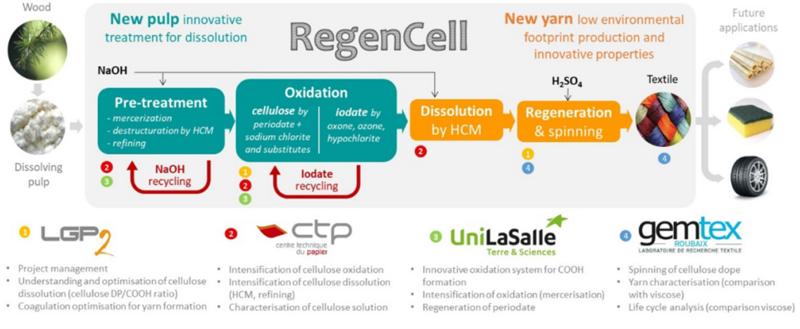
REGENCELL (2023-2026)
Clean process for dissolving wood cellulose to produce textile yarns
The RegenCell project is supported by the French National Research Agency (ANR), coordinated by the LGP2 laboratory and also involving the CTP, the UniLaSalle Polytechnic Institute and the Gemtex laboratory. Its aim is to develop a new textile production process based on wood cellulose, as an ecological and cost-effective alternative to the current viscose process.
Aim of the project
RegenCell aims to offer an ecological and cost-effective alternative to the viscose process. Every year, 6 million tonnes of wood cellulose yarn are produced worldwide for textile applications, 80-90% of it using the viscose process. But this process poses serious pollution problems.Two main objectives have been identified for this project :
- To develop a cellulose dissolution process operating in an aqueous medium and at ambient temperature, using a minimum quantity of non-toxic reagent, thus guaranteeing a low environmental impact. The reagents are chosen so that the process can be integrated into a cellulose production unit (Kraft plant) at a competitive cost.
- To obtain new filaments with a quality similar to viscose and with innovative and controlled properties.
A first step and one of the main difficulties of this project is to be able to dissolve cellulose in an aqueous medium. To achieve this, it is necessary to reduce the hydrogen and hydrophobic interactions of the cellulose fibres. The approach adopted in this project is to introduce carboxyl groups (COOH) into the cellulose by means of moderate oxidation.
Secondly, the process needs to be cost-effective compared with viscose. RegenCell’s strategy for meeting this challenge is to regenerate sodium periodate using a ‘green’ oxidant, such as ozone, oxone or hydrogen peroxide.
Finally, the project will also focus on the development of yarns of at least equivalent quality to viscose in terms of strength and elongation. The presence of carboxyl groups on cellulose will provide additional specific properties that can be exploited in a wide range of applications.
The project will also take into account the entire cellulose value chain, from the production of dissolving pulp to the manufacture of yarn integrated into the pulp mill, as well as the preliminary life cycle assessment (LCA) of the product and its comparison with the LCA of viscose.

1. ANR : National Research Agency
2. LGP2 : Paper Process Engineering Laboratory